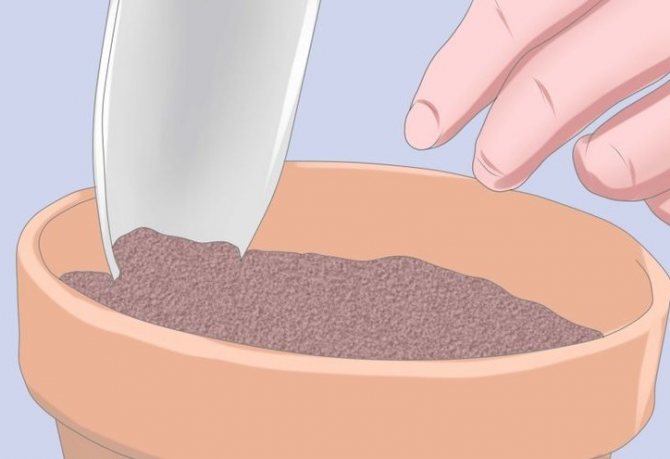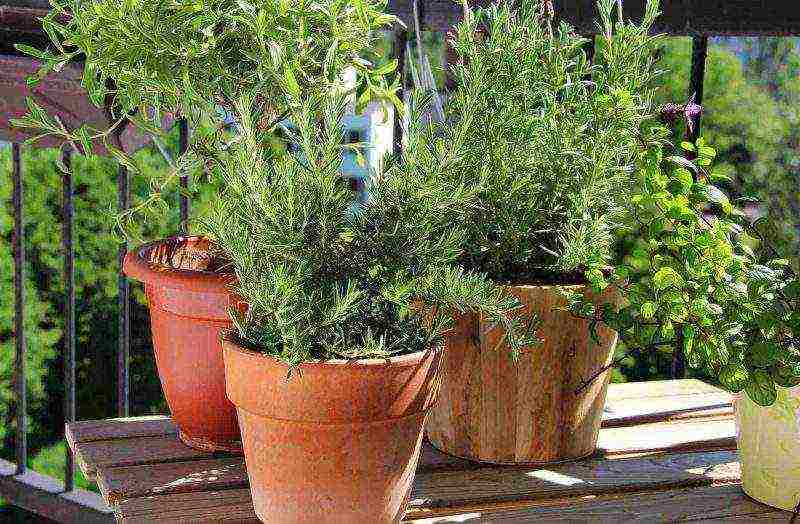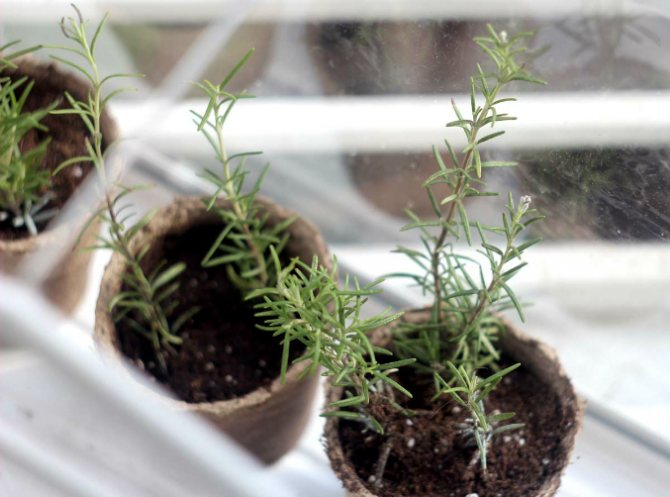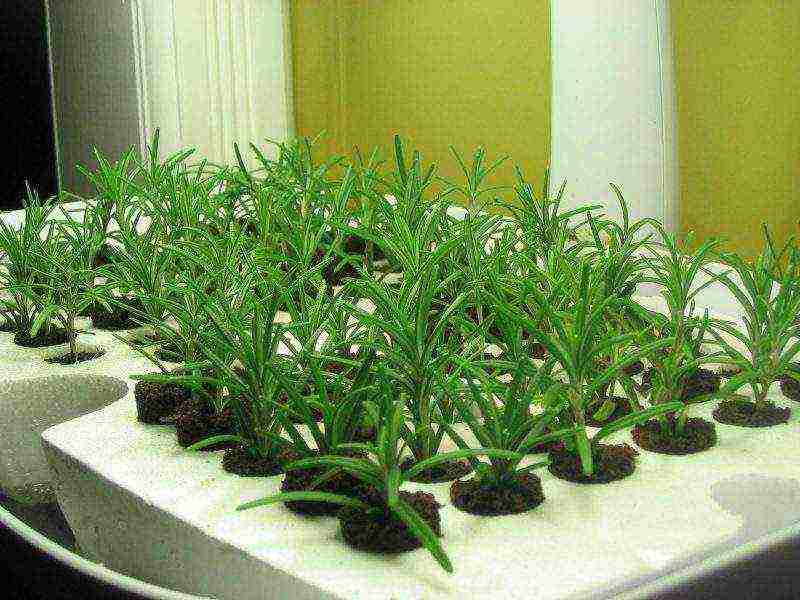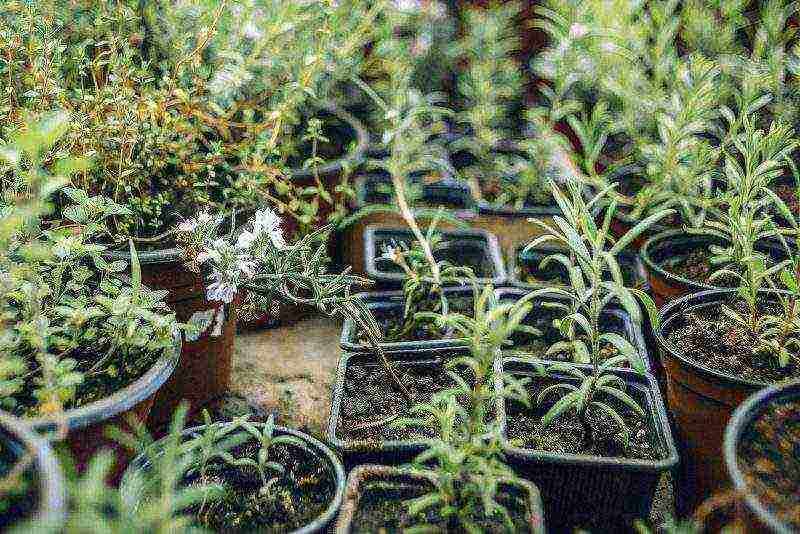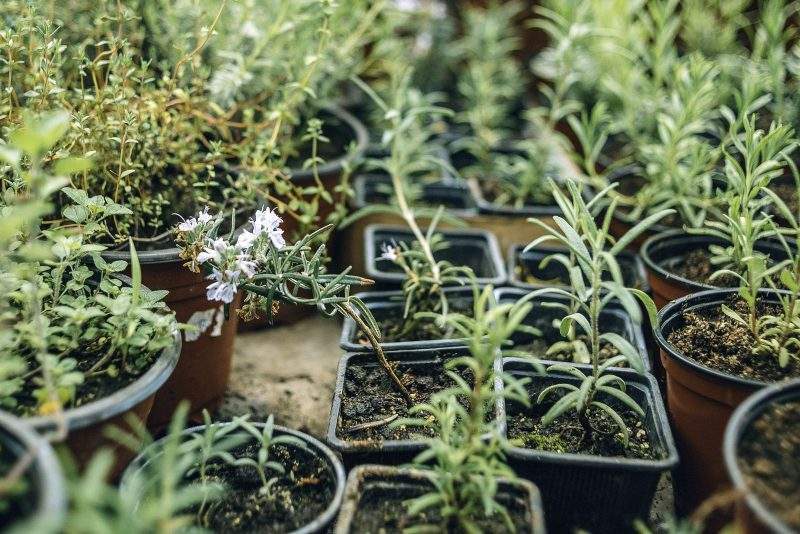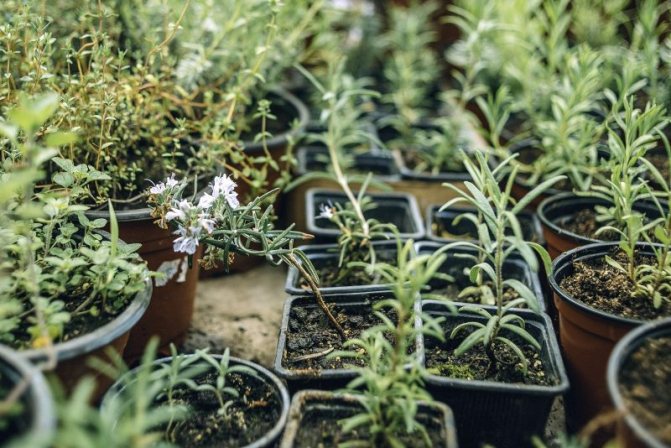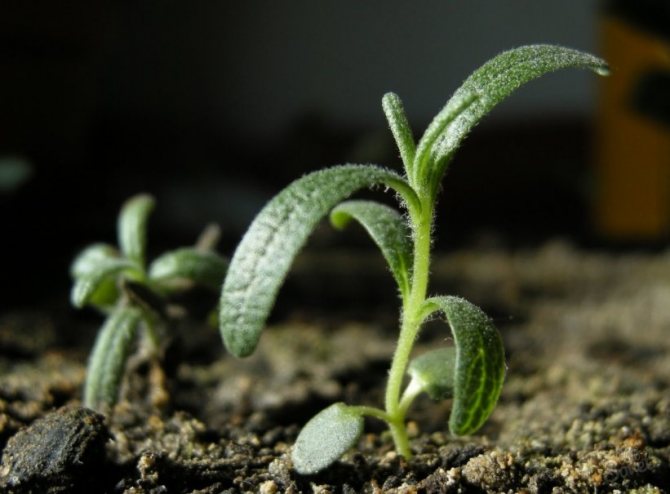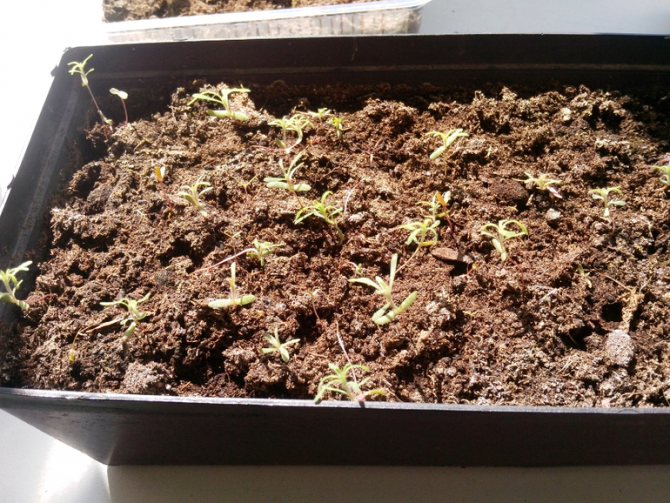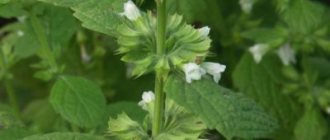Until recently, rosemary was considered an exotic plant and an unusual seasoning for our cuisine, but recently it has become more and more popular.
Not everyone knows that rosemary can be grown in an apartment, and not only in gardens, vegetable gardens and other open areas, and sometimes it takes root in the house better, as it loves warmth. In this article, we will tell you in detail how to grow such unusual, fragrant and very healthy greens right on your windowsill.
Rosemary: the nuances of growing a house in a pot
If comfortable conditions are not created for the plant, it begins to gradually lose its attractiveness and useful properties. Ideally, grow a flower in a winter garden, but if it is absent, you can do it in an apartment. Rosemary in good conditions becomes a small tree, which should be considered when choosing a plant.
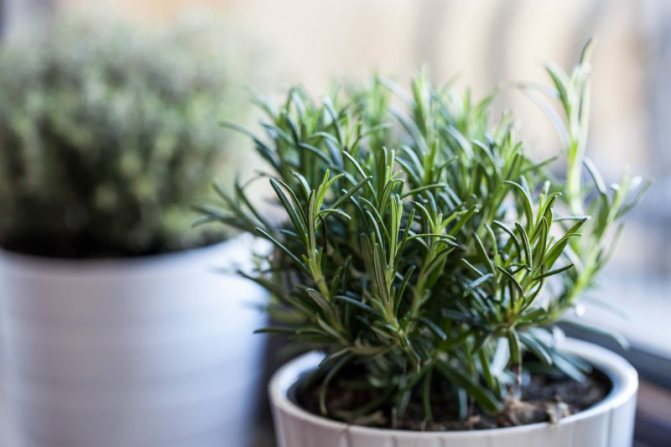
It is also worth remembering that if the wrong care is taken, it starts to hurt and may die. In the summer, it is necessary to take the flower out into the fresh air. This will improve the development of the bush, increase the content of nutrients in it.
Brief description of rosemary with photo
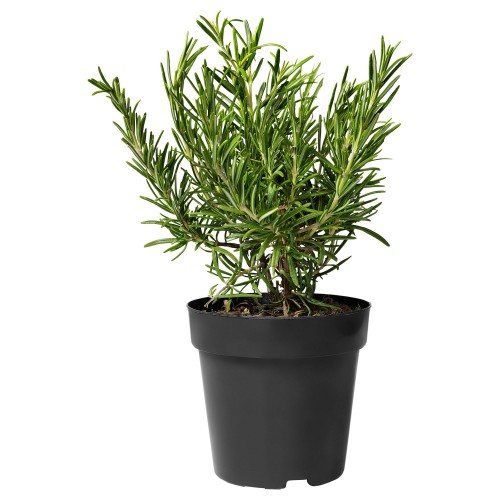

Rosemary is an evergreen shrub belonging to the Lipo family. Under natural conditions, it grows very quickly, every year by about 20 cm. The maximum height of an adult perennial is 2 m. Domestic specimens are much lower than their "wild companions". Wild shrubs can grow in one place for 10-15 years, in a room (with proper care) - 20-30 years.
Brief botanical characteristics of rosemary:
- the root system is powerful, woody and branched, the stem is erect, gray-brown;
- branches are branched, tetrahedral, pubescent;
- leaves are leathery, linear, opposite, up to 3.5 cm long, up to 0.4 cm wide;
- flowers are small, bluish-purple in color, collected in inflorescences;
- the fruit is round, outwardly reminiscent of a small brown nut.
Fresh, slightly bitter leaves have a pronounced aroma, reminiscent of a complex mixture of eucalyptus, camphor, lemon, pine. Flowering occurs in April-May, and the seeds ripen only in September.
Attention!
Rosemary, placed in the room, effectively cleans the air from pathogenic microorganisms. This is due to the antibacterial effect of the essential oils that make up the herb.
Rosemary contains not only essential oils, but also a whole range of useful substances. For medicinal purposes, the leaves of the plant are used. Fresh or dried leaves are added to many dishes. The aromatic spice is very decorative. It is often used in landscape gardening, both in group and in single plantings. Rosemary hedges look spectacular.


Planting a plant
Its further development depends on how correctly the flower is planted. Mistakes during the planting phase lead to the fact that the rosemary begins to wither and may die.
Requirements for soil and pot
The result of growing a plant depends on the correct choice of pot and soil. Rosemary root is very branched and needs a spacious container. The roots have a high oxygen demand, and therefore the pot material must be porous. Clay is the best choice.Coated pots should not be used. A pot with an average diameter of about 20 cm is suitable for a young plant.
The plant needs special soil. At a flower shop, you can buy a lime-based gravelly substrate, but it is better to prepare a soil for rosemary yourself.
For this, the following components are connected:
- leafy soil - 2 parts;
- sod soil, from which all roots have been removed - 2 parts;
- humus - 1 part;
- coarse river sand - 1 part;
- peat - 1 part.
Before the plant is planted, the soil must be very well shed with water.
Choosing a landing site
Rosemary is very sensitive to external conditions, does not tolerate temperature surges and cold. The best place to grow it is in a sunny, wind-protected area. The southern and eastern sides of the vegetable gardens are the most priority for the plant.
The shrub loves light sandy, non-acidic and drained soil, because such land perfectly permeates water, without holding it back at all. In addition, its looseness allows the root system to be saturated with oxygen.
In the case of a predominance of acidic soil in the area, it must be calcified. To prevent excess soil moisture, drainage should be laid at the bottom of the planting hole. Mostly it is purchased in stores or large pebbles and broken bricks are used.
Rosemary is very sensitive to external conditions, does not tolerate temperature surges and cold. The best place to grow it is in a sunny, wind-protected area. The southern and eastern sides of the vegetable gardens are the most priority for the plant.
In the case of a predominance of acidic soil in the area, it must be calcified. To prevent excess soil moisture, drainage should be laid at the bottom of the planting hole. Mostly it is purchased in stores or large pebbles and broken bricks are used.
Rosemary is classified as a plant with increased sensitivity to temperature extremes and frost. Gardeners, who plant the spice every year, advise planting it in sunny areas. Also, an area that is protected from gusts of wind is ideal for landing.
When choosing a site for rosemary, you must take into account the characteristics of the soil. The spice grows best in drained soil with low acidity. Such soil absorbs moisture well and is constantly saturated with air. If it is not possible to plant a plant in loose and non-acidic soil, you will have to add a little sand to it and lime it.
Home care for rosemary
In addition to proper planting, the plant needs full care, in which the fragrant herb will receive everything it needs. By the attractive appearance of the plant, you can immediately understand that it is good for it and that there is sufficient care for it.
Temperature, humidity and lighting
During the growing season, the plant requires an air temperature of +23 to +25 degrees. In winter, rosemary goes into a dormant state, and therefore requires a decrease in temperature. It should be between +6 and +15 degrees. In an apartment, it is rare, it turns out, to create an optimal temperature. So that the rosemary growing in the apartment does not suffer from overheating, in winter it must be placed as close to the window as possible. Also, for cooling, you can put a bowl of snow or ice next to it, which, melting, will slightly lower the temperature around the plant.
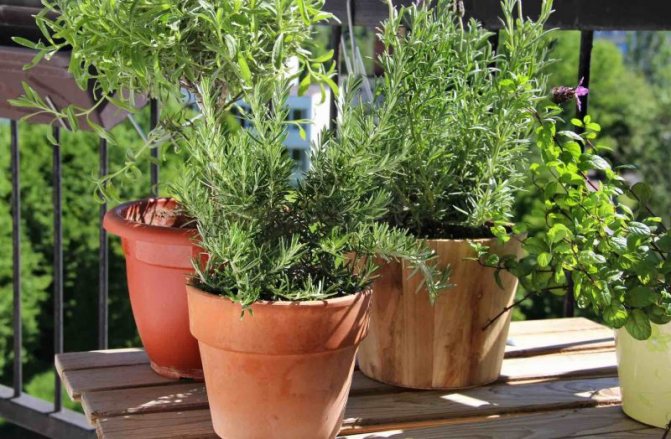

Air humidity is an important indicator, since when it is insufficient, the indoor flower begins to turn yellow and wither. In summer, in most cases, additional air humidification is not required for the plant. In winter, due to heating, the air in the room becomes drier, and therefore it is necessary to increase the humidity. To do this, expanded clay is poured into the pallet with the plant, which is abundantly moistened.Water should not reach the drainage holes of the pot, so there is no risk that the plant will rot due to excessive soil moisture. At the same time, due to the evaporation of water, the air around the rosemary becomes humid enough for it to function normally.
The plant is light-loving and requires intense lighting for at least 6 hours a day. In order for the crown of the shrub to develop evenly, and not one-sidedly, once every 2 days, the pot must be turned 180 degrees. In the summer heat, so that the grass does not get sunburn, it must be slightly shaded. In winter, the lighting should be as intense as possible. It is good to use phytolamps for supplementary lighting of a flower, the light spectrum of which has a beneficial effect on the growth of indoor plants.
Interesting: rosemary: medicinal properties
Watering the plant
When growing rosemary at home, it should be remembered that it tolerates overdrying more easily than overmoistening. However, despite this, the flower should be watered regularly, using well-separated water at room temperature.
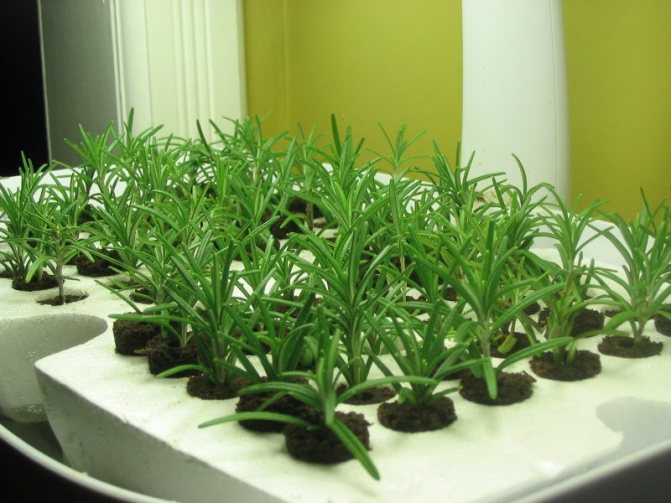

If the plant lacks water, its foliage will begin to turn yellow. When there is too much of it, the rosemary begins to shed the leaves, which at the same time retain their green color.
The signal that it needs to be watered is the drying out of the top layer of the earth. It is unacceptable to wait until the soil is completely dry. In extreme heat in summer, it is useful to spray the grass early in the morning or late in the evening, but not more often than once a day. For this, the same water is used as for irrigation.
Top dressing and fertilization
Rosemary is fed during the growing season from spring to November 1 time per month using a complex fertilizer for indoor plants. It should be diluted in twice the volume of water compared to the instructions in the instructions. It is also useful to water 2 times a season with an aqueous solution of bird droppings, prepared at the rate of 1:30.
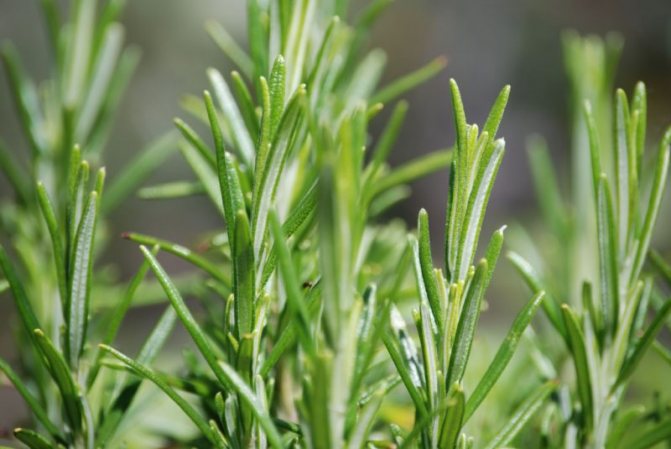

In winter, it is highly undesirable to feed rosemary. If it begins to weaken due to a lack of nutrients, then a one-time feeding with a complex composition is allowed. This phenomenon usually occurs when the plant has not been transplanted on time.
Transfer
Up to 5 years old, rosemary actively builds up the root system. For this reason, in the early years, it must be transplanted every April into a pot that will be 5-7 cm wider than the previous one. After 5 years, the flower is transplanted once every 3 years, also in April. In this case, the pot should be 10-12 cm wider than the previous one.
Preparing cuttings
People who have never experienced cuttings before often make mistakes when preparing cuttings for planting. Therefore, it is recommended that you familiarize yourself with the features of preparing seedlings for further planting.
There are several rules to help prevent future problems:
- Prepare containers in advance for planting spices and the soil in which it will be planted. When preparing the soil mixture, black soil is mixed with humus and peat.
- A thin layer of pebbles is laid out on the bottom of the pot in which the rosemary will grow, and the soil mixture is poured on top.
- Make small holes for planting spices. Their depth should be 3-4 cm.
- The containers with the planted rosemary cuttings are transferred to a sunny place for germination.
Many gardeners have a common mistake in growing rosemary using cuttings. They do not withstand the seedlings for a certain amount of time for the formation of roots and plant them directly into the soil. As a result, the cuttings do not take root and die.
To avoid problems, you must adhere to the following rules:
- Prepare the pot for the plant and the soil (you can get the substrate from the store). If the soil is harvested independently, then you need to mix black soil, peat, sand and humus.
- Place small pebbles at the bottom of the container, then pour earth and moisten it.
- Make small holes and bury the seedlings 3-4 cm deep. Be sure to cut off the lower leaves and water the soil again.
- Put the container with cuttings on a warm and sunny windowsill for 1-1.5 months.
Attention! The rosemary should be watered at least four times every seven days and the water should not be allowed to stagnate in the pot. It must be drained if it has gathered on a saucer.
- Remove the rosemary seedlings and transplant them to an outdoor area.
Many gardeners have a common mistake in growing rosemary using cuttings. They do not withstand the seedlings for a certain amount of time for the formation of roots and plant them directly into the soil. As a result, the cuttings do not take root and die.
A good way to root the twigs of a plant is to place them in jars of water. It needs to be updated every 3 days. It is important to provide the twigs with light and heat.
Rosemary is very sensitive to soil type. It does not tolerate alkaline, clay and heavy soils. For the plant to feel great, it is recommended to loosen the soil, this will not allow water to linger. The shrub does not like dry weather, and excessive watering can lead to root rot.
Prepare the pot for the plant and the soil (you can get the substrate from the store). If the soil is harvested independently, then you need to mix black soil, peat, sand and humus. Place small pebbles at the bottom of the container, then pour earth and moisten it. Make small holes and bury the seedlings 3-4 cm deep. Be sure to cut off the lower leaves and water the soil again. Put the container with cuttings on a warm and sunny windowsill for 1-1.5 months.
Remove the rosemary seedlings and transplant them to an outdoor area.
Propagation of rosemary
Breeding a plant through seeds at home is quite problematic, and therefore the propagation method is mainly used. To obtain new plants, the apical shoots 7.5 cm long are cut off. They should be cut with sharp scissors at an angle of 45 degrees. The cuttings are moistened in clean water and the place of the cut is rolled in "root" powder. Then the excess powder is shaken off and the cuttings are planted in moist peat. The container with them is covered with a plastic bag, since greenhouse conditions are necessary for rooting. The roots appear in a month or a little earlier. Further care is carried out according to the standard scheme.
What varieties are suitable for home cultivation
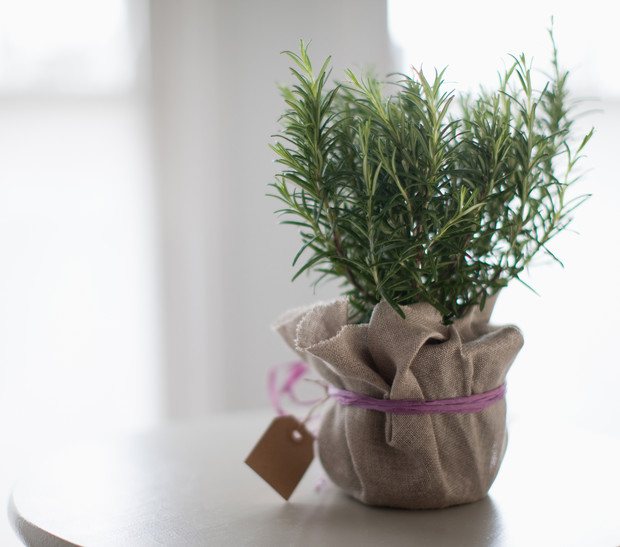

It may be interesting What to do if there are signs of powdery mildew on rosemary How to keep rosemary fresh and dry Thyme: species and varieties with descriptions and photos
The genus of the same name includes 5 plant species. Not all are suitable for growing in a room. Only one type of rosemary is suitable for keeping a house - medicinal, or ordinary. The following dwarf varieties are used to grow grass at home:
- Richard;
- Fragrant;
- Tenderness;
- Ampelny;
- Dewdrop.
All varieties are suitable for growing in pots. Perennials cultivated from these varieties differ in size, length of leaves, color and shape of flowers. They have medicinal properties and are suitable for consumption.
The main problems in growing
The main problem that a florist may face is powdery mildew. She, due to the peculiar leaves of rosemary, does not appear in the usual way. As a result of this, without being noticed, the disease progresses, and the plant dies from it. You can suspect the presence of a problem by browning the leaves. Growing rosemary in an apartment can also be complicated by higher than required temperatures in winter, when the plant should be dormant.
About varieties
As mentioned above, ordinary medicinal rosemary is divided into several varieties, which differ in flowering (the color of the flowers may be different), the shade of the leaves, size and character.
The following varieties of rosemary are best suited for indoor cultivation:
- "Lavender",
- "Tenderness", growing from seeds of which give the most successful results,
- varieties "Rosinka" and "Roseus" also take root in apartments quite well.
But in general, there are no restrictions on the varieties, you can try to grow any shrub of the "ordinary rosemary" species.
How to get a healthy perennial plant?
To grow rosemary to a good result, you only need to follow a few simple rules.
Temperature
At home, try to keep the adult plant at a temperature within the 15 to 25 degrees range. In autumn, rosemary can be grown on the balcony, where the minimum temperature is approximately 11-12 degrees.
If you keep rosemary on a windowsill, try to open the window less often so as not to create sudden temperature changes that can cause the plant to lose some of its leaves.
Lighting
It is better to install a plant at home on a southern windowsill, since in natural conditions it receives a lot of natural sunlight. Special light filters are not required - however, in winter, you can turn on a phytolamp over it at least once a day to avoid the lack of ultraviolet radiation necessary to ensure the normal level of leaf health.
The largest bushes in the cold season can be transferred to special greenhouses - for example, growing rosemary can be carried out on a balcony or loggia, provided that the above temperature is maintained there.
Moisturizing
Maintenance also includes keeping the air slightly humid - if your home does not have a new heating system and monolithic walls, you can do this about once a week. Otherwise, with great aridity, it is possible to grow large rosemary in a pot on a windowsill only if the spraying frequency is doubled.
Watering is carried out approximately every three days - at home, proper care requires that the soil is only slightly moist most of the time. However, when the temperature inside the house exceeds 25 degrees, rosemary requires a lot of watering every day.
Diseases and pests
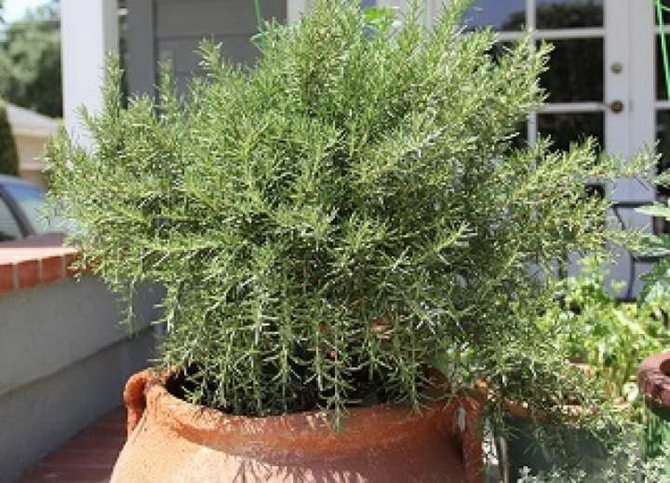

If the rosemary is not properly cared for, it increases the likelihood of insect pests on it, and the plant can also get sick. When a spider mite appears, the lower surface of the leaves is covered with a whitish bloom, and a thin cobweb can be seen on the branches. The mite parasitizes in a room where the air is dry, so leaves also fall from the bush. Damaged foliage must be torn off, and the plant must be treated with a solution of laundry soap. 30 g of soap are diluted in 1 liter of water and washed 3 times every 2 days. From insecticidal preparations Fitoverm is used. Aphids are fought by spraying with Biotlin. If a whitefly appears, it is advised to use an infusion of dandelion roots and leaves. 50 g of the product is poured into 1 liter of water and left to infuse for 4 hours. The resulting infusion is sprayed on the plant once every 7 days until the insect disappears. You can use the purchased product "Aktara". The preparations "Bankol" and "Mospilan" will help to get rid of the scabbard.
Requirements for conditions
Before you figure out how to grow rosemary, you need to consider its requirements for soil and environmental conditions:
- Soil - this crop requires a light, well-drained, close to neutral soil or soil consisting of low-lying peat, coarse sand and garden soil in a ratio of 1: 2: 2;
Advice. The pleasant aroma of rosemary leaves is best shown when grown in slightly alkaline soils. Therefore, for the preparation of a soil mixture or planting it in open ground, it is imperative to measure the acidity level using a litmus indicator strip. If the acidity is high, it is calcined with chalk or wood ash.
- Soil moisture - this plant does not tolerate flooding by groundwater and waterlogging of the soil. Therefore, if it provides for growing rosemary in pots or containers, a layer of drainage is laid on their bottom.In the open ground, soil moisture is regulated by irrigation and planting placement in a high area that is not flooded by top water or groundwater;
- Lightness - Rosemary likes places that are well lit during the day. In the shade and partial shade it grows and develops poorly, often overgrown with more hardy weeds;
- Temperature regime - the plant feels good at high temperatures. Able to withstand short-term frosts. Long-term frosts below -12 ° C are destructive for rosemary.
Rooting methods
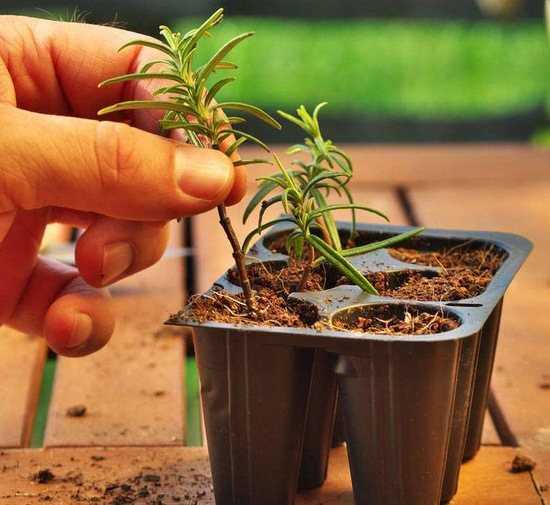

To plant a rosemary with a cuttings, it must first be rooted, i.e. create conditions conducive to root growth. This requires small cups with a volume of 200-250 ml, water or universal soil for seedlings. Instead of soil, hydrogel and various mixtures are used:
- soil + sand + drainage;
- equal parts of leafy earth, peat and sand;
- coconut flakes + drainage;
- vermiculite + sand.
When rooting in water, several branches can be placed in one cup, fixing them on a cardboard with holes - cardboard reduces moisture evaporation, gives stability. Fast rooting is facilitated by the addition of ½ tablet of activated charcoal. If rooting in the ground is supposed and it is planned to grow in a flowerpot, a large pot, then it is advisable to place 2-3 cuttings in one glass so that they can be transplanted in a coma of earth without dividing, if the seedlings are planted in open ground, then it is better to put one in a glass stalk. A cut of the cuttings placed in the ground is treated with Kornevin.
On a note!
It is recommended to place the twig closer to the wall, deepening it into the mixture (water) by 2 cm. According to gardeners, with this placement it is convenient to observe the growth of roots, and rooting in this case occurs faster.
The container is covered with a translucent bag and placed in a warm, bright, but not in direct sun, place. Care consists in airing the greenhouse, moistening the soil, adding water. During rooting, it is important to prevent stagnation of moisture, drying out of the soil, hypothermia - in such conditions, the roots may not appear.
The healing properties of rosemary and its uses
In its composition, rosemary contains antioxidants, B vitamins, essential oils and other beneficial substances. The bitter taste of the herb is created by carnosol, rosemanol and rosmarinic acid.
The therapeutic effect is directly exerted on the human body by flavonoids - apigenin and luteolin.
In Medicine and Cosmetology
Try this organic rosemary oil
The content of essential oils makes an excellent basis for the manufacture of many medicinal preparations with a calming and relaxing effect.
Rosemary essential oil is one of the most versatile and should always be in your medicine cabinet. It has many of the most beneficial properties for the healing of our body.
This plant contains phytoncides that act as antioxidants. Valuable oils and resins are used:
- with insomnia;
- as an expectorant and diuretic;
- with diseases of the gallbladder;
- with diseases of the gastrointestinal tract;
- for the treatment of the liver;
- with diabetes.
The aroma of this herb has a beneficial effect on children, pregnant women, people with an unbalanced nervous system.
A pleasant aroma in the room, if you plant rosemary on the windowsill, will help to overcome stress, relieve fatigue and depression.
Rosemary in cooking
Rosemary has a very broad spectrum of activity in cooking.
Flowers and leaves of the plant make a fragrant spice, which is used to prepare various dishes.
Vinegar is infused with the seasoning, wine is added to meat and fish sauces.
The plant is also used fresh (the tops of the shoots with flowers and leaves).
Due to its pine-camphor aroma, as well as a spicy, slightly bitter taste, the herb is ideally combined with eggplants, cabbage, beans, mushrooms, fruit salads. Rosemary essential oils are often used for baking and in alcoholic beverages.
How to Grow Luxurious Rosemary from Seeds
Seeds-nuts remain viable for 3 years. It is required to store the seed in paper bags. The seeds do not need pre-sowing treatment, they can be sown in autumn or spring.
Before sowing, it is recommended to soak the seeds for 2-3 days in a damp cloth. As it dries, the material must be moistened. During this time, the seeds will swell a little, and it will become clear which ones are suitable for sowing, and which ones can be thrown away. Seeds are sown in prepared pots with fertile moist soil, scattered over the surface. After sowing, watering is not required, you just need to cover the containers with polyethylene and put them in a warm, bright place.
Attention! Rosemary seeds sprout within a month! If during this time the sprouts have not appeared, it is recommended to renew the crops, but plant them in new containers. To properly grow rosemary from seeds, you must follow the rules.
- During the month, it is necessary to regularly ventilate the greenhouse so that the earth does not oxidize and the seeds do not rot.
- Water only as the topsoil dries up. Watering should be fine, from a spray bottle.
- When 3 true leaves appear on the plant, you need to thin out the plantings or cut the seedlings into separate cups.
- During transplantation, the root system must not be damaged, otherwise the "rosemary" will develop poorly.
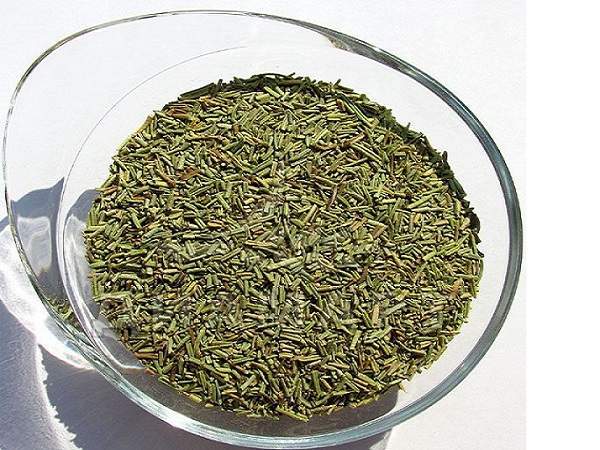

As the plants grow, they are transferred to a larger pot to provide the root system with enough room to develop.
For your information! In winter, rosemary grows well in the winter garden. Growth requires a temperature of +12 ºC to +20 ºC. When kept in a hot room, the plant will lose its decorative effect and begin to shed its foliage.
Lower temperatures have a negative effect on the plant: the root system is supercooled, which leads to the death of the plant.
Signs and benefits of a plant for the home
Growing rosemary at home in a pot, you can simultaneously get a beautiful plant, a delicious spice and a natural air freshener.The history of growing shrubs dates back to ancient times, because then rosemary was considered a symbol of Aphrodite, the goddess of love and beauty. People believed that the plant is capable of maintaining youth, as well as putting in order thoughts and feelings.
Currently, it is believed that rosemary blooms only with a "real" mistress, who holds in her hands not only her house, but also her husband. Therefore, a healthy, branched and flowering shrub is a compliment to a woman from nature itself.
The bush leaves contain an essential oil rich in phytoncides and antioxidants that freshen the air and cleanses it of harmful impurities and particles. The scent of the bush helps to relax and relieve stress, balancing the emotional state of the person.
Rosemary is rich in nutrients and vitamins, due to which its oil is actively used in folk medicine for the treatment of various pathologies, such as migraine, diabetes mellitus, neurasthenia, inflammation of the kidneys, liver and gastrointestinal tract.
Due to the fact that the plant has a specific coniferous smell, it is a popular spice that will add an exquisite taste to any meat, fish and vegetable dishes. Drinks with the addition of rosemary sprigs can energize and invigorate a person.
The plant will purify the air, bring peace to the house, and will also be a great addition to any dish, be it a side dish or dessert.
Step by step guide
Growing rosemary in a pot at home is not an easy task; proper keeping conditions must be observed. If they are violated, the plant will begin to ache, lose its decorative effect, taste and medicinal properties. The presence of homemade rosemary will help relieve nervous stress in households and make them calmer.
Attention!
An important condition is the penetration of sunlight into the apartment. If it is not enough, you need to take care of the organization of additional lighting.
A flower standing in one place for a long time without movement will grow unevenly.Therefore, from time to time it should be turned towards the light source with the opposite side. Reproduction of rosemary is carried out by seeds, cuttings and dividing an adult bush.
Possible mistakes
Some, when growing in an apartment from medicinal rosemary seeds, make mistakes, due to which its condition worsens. It must be remembered that a plant needs 10 hours of light to grow normally. But also prolonged exposure to direct sunlight on the parts that are located above will not be beneficial. The foliage will become faded and lethargic. Therefore, it is better to organize diffused lighting. Do not over-water the bushes. Top dressing should be done at the right time.
Creating the right microclimate in the apartment where the plant grows is the main thing. You need to periodically prune rosemary at home, give the bush the desired shape. After a haircut, it begins to grow better and more actively. The bush becomes much more luxuriant. But 2/3 of the cut young shoots should remain. Only in this case will the plant tolerate the procedure normally. If cut to old wood, the rosemary will weaken and become susceptible to disease.
Rosemary essential oil is very beneficial. It has a choleretic, hypotensive, diuretic and antioxidant effect.
Transplant into the ground: timing
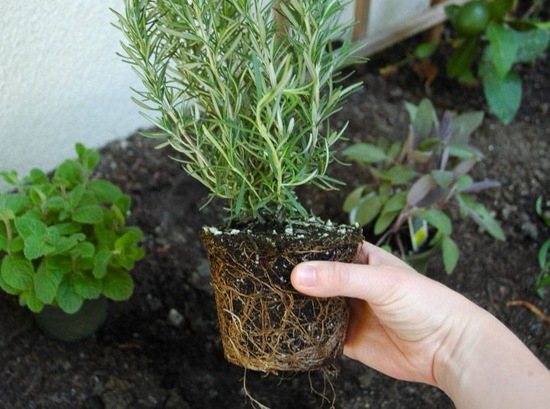

For planting rosemary, a place is selected where the conditions are similar to the natural growing environment - a semi-shady, but not shady, area where the sun is at least half of the daylight hours. It must be protected from through winds by trees, bushes, buildings. The culture prefers loose, fertile soil; it does not grow on heavy, alkaline soils.
Growing seedlings
1. Preparation of seeds and planting containers
Seed material retains its quality characteristics for three years after collection, but still has a low germination rate. To encourage seeds to germinate more actively, it is recommended to immerse them for several hours in a vessel with ordinary water at room temperature before sowing. Swollen seeds can be sown immediately.
It is important that all containers selected for seeding contain drainage holes. Before filling them with soil, disinfecting treatment is carried out - scalding with boiling water, washing with manganese or soap (based on laundry soap) solution.
Soil preparation and sowing dates
A suitable soil mix can be a commercial all-purpose (peat-based) soil mix or one made from forest soil and compost. The bottom of the planting box is filled with expanded clay, crushed foam or nut shells, or any other drainage material.
The whole box is filled with the substrate and poured with a special sweet solution prepared from one tablespoon of honey and one liter of warm water.
A favorable time to start sowing is late February - early March.
Sowing features
Seeds are spread over the surface of wet soil at some distance from each other, slightly pressing into the soil, sprayed with a spray bottle and covered with glass or transparent plastic wrap.
Conditions of detention
Before germination, crops require daily ventilation, moderate moisture and maintaining a stable temperature within twenty-six to twenty-eight degrees of heat.
After the sprouts appear (after about three to four weeks), the shelter is immediately removed. Seedling boxes are transferred to cooler conditions with good lighting. This could be a window sill on the south side of the house.
If there is a lack of natural light, it is recommended to use additional illumination in the form of an LED lamp (phyto / lamp) or a fluorescent lamp.
The temperature range in which the seedlings should develop is from fifteen to twenty-five degrees Celsius. It should be lower at night than during the day.
Moistening the soil should be done twice a week.
Transplanting seedlings to a permanent place is performed when its height reaches eight to ten centimeters.
Growing Secrets: How to Make Rosemary Blossom
Rosemary is also planted for the sake of flowers for use as a seasoning, but growing at home from seeds does not always culminate in the flowering of the plant.
There are a few tips from experienced growers to help you get your rosemary to bloom. First of all, you can try to transplant it into peat, deciduous or sod soil with the addition of humus and sand.
This procedure is recommended every spring.
Secondly, the plant must definitely survive the cold period, when the temperature of its environment drops to 5-10 ° C. During this period, it is necessary to reduce watering and not touch the plant, tearing off leaves from it or cutting it. Flowering should be expected in April - May.
As you can see, it is quite possible to grow rosemary at home on a windowsill, but for this you need to be patient and knowledgeable. But your efforts will pay off with a beautiful lush plant that can be used as a seasoning for your favorite dishes.
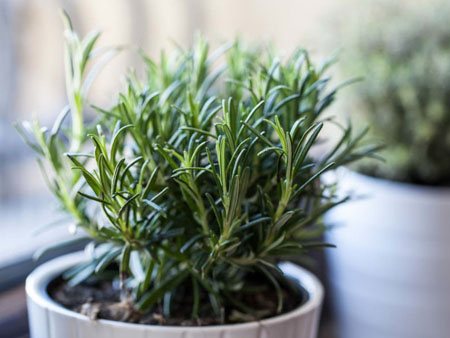

We are all used to buying a fragrant seasoning in sachets - rosemary. The herb goes well with meat and fish dishes.
Rosemary sprigs give the dish a piney aroma with hints of citrus and camphor. Literal translation from Latin means "sea freshness".
Common rosemary has beneficial properties: relieves stress, tones, and aids digestion.
The plant contains rare essential oils and tannins. Few know how to grow rosemary at home.
How to plant and grow on a windowsill - features, conditions and step-by-step instructions
When growing rosemary on a windowsill, it is important to comply with all agrotechnical requirements. Only a bush growing in a favorable environment will serve as an interior decoration, a storehouse of useful substances and unique taste.
What should be the place
Before you get a spicy plant, you need to familiarize yourself with its characteristics in advance. The following information will help you determine if your rosemary will be able to create the right conditions.
Temperature
The optimum temperature in the room where the rosemary pots are located is+ 12- + 16 C... Warmer environments are bad for spring blooms.
Important! Rosemary reacts to sharp fluctuations in temperature by dropping leaves.
Humidity
So that the plant is not attacked by fungi, the air humidity in the apartment should be below average. Rosemary will grow rapidly if the room is ventilated daily for 2-3 hours. In winter, air circulation can be arranged using a conventional fan.
The potting medium should be constantly moist, but never wet. It is better to underfill the rosemary and allow the soil to dry out for a short time than to turn the soil mixture into a swamp.
Illumination
In order for rosemary to form leaves more actively, in winter a light-loving plant must be placed on the south or east windowsill. In the summer, a container of rosemary is transferred to the balcony or planted on the site. The pot must be periodically turned towards the light by one or the other side. Thus, deformation can be avoided when the plant bends to one side of the light, which often happens when growing light-loving plants on a windowsill.
On short winter days, rosemary gratefully responds to morning and evening supplementary lighting with fluorescent lamps.
What container to plant
Due to the fact that the root system of rosemary is highly branched, the plant must be planted in spacious clay or terracotta pot. The optimal dimensions of the planting container: height 15-20 cm, width 25 cm.Deviations from the recommended values downward by 3-5 cm are allowed.
What kind of soil (substrate)
To plant rosemary on a windowsill in an apartment in a flower shop they buy neutral or slightly alkaline soil for growing seedlings. Instead of purchased soil, you can use a mixture of garden soil and sand. The main condition is that the soil must be loose and breathable. Before planting, the bottom of the pot is laid with a layer of drainage through which excess water will flow into the pan.
Preparing seeds or cuttings for planting
Semyonand rosemary sprout very long and poorly: seedlings make their way to the surface only a month after sowing. To accelerate the emergence of seedlings, on the eve of planting, the seeds are soaked for 24 hours in water or a growth stimulator.
Cherenko preparationin rosemary for subsequent cultivation on the windowsill is carried out in the following sequence:
- In late spring, on a healthy bush, the tops of young shoots 8-10 cm long are cut off.
- Planting material is cleaned from foliage
- The cut sites are dipped in a growth stimulator, thanks to which roots are formed faster.
Direct landing
All preparatory work will be useless if the landing is not correct. The procedure depends on the type of planting material.
Seeds rosemary is sown in this way:
- The planting material is evenly spread over a container covered with a damp substrate. Please note that due to poor germination of seeds, you need twice as much as you plan to get seedlings.
- Sprinkle them on top with a 0.5 cm layer of moist earth
- The container with crops is covered with glass or foil and placed in a warm place where the temperature is + 25- + 30C. Lighting is irrelevant at this stage.
- As soon as the seedlings hatch, the box is gradually opened and transferred to a bright place. Moisten the substrate as needed using a spray bottle.
Landing cuttings rosemary for growing on a windowsill is carried out as follows:
- To prepare the substrate, sand is mixed with peat moss.
- Prepared cuttings are buried in the soil at an angle of 30-45 degrees.
- The container is covered with a film and holes are made in it so that fresh air can flow to the handle.
- The box is placed in a warm, bright place. The mini greenhouse needs to be periodically opened and sprayed.
- At 3-4 weeks of age, new plants can be transplanted into a permanent pot.
Video: features and difficulties of growing rosemary in a pot at home
Common questions
Growing rosemary on a windowsill is pretty easy. It is enough to follow the elementary recommendations regarding its care in order to get a beautiful shrub that will become a pleasantly smelling "highlight" of any interior. Rosemary is a plant that is able to thank a person for their care, purifying the air and giving a sound sleep.
Due to their wonderful aroma, rosemary sprigs have been used in cooking for several centuries for the preparation of many dishes. The substances contained in the spice plant improve mood and relieve stress. In addition, rosemary releases essential oils that kill disease-causing bacteria.

